(CNN) -- A charred body, such as that found in a California cabin amid a manhunt for an ex-police officer, can be relatively easy to identify, experts said, especially if authorities have an idea of whose it is.
Officials are working to determine whether the body, discovered after a shootout that left one deputy dead and a second wounded, is that of Christopher Dorner.
Suspected in the deaths of three others, Dorner, a former Los Angeles police officer, has been the subject of a six-day manhunt. He apparently vowed to kill police officers to avenge what he said was an unfair termination.
"We do cases like this all the time," said Dr. Mark Bernstein, a Louisville, Kentucky, dentist who is a forensic dental consultant for the state's chief medical examiner.
.cnnArticleGalleryNav{border:1px solid #000;cursor:pointer;float:left;height:25px;text-align:center;width:25px} .cnnArticleGalleryNavOn{background-color:#C03;border:1px solid #000;float:left;height:25px;text-align:center;width:20px} .cnnArticleGalleryNavDisabled{background-color:#222;border:1px solid #000;color:#666;float:left;height:25px;text-align:center;width:25px} .cnnArticleExpandableTarget{background-color:#000;display:none;position:absolute} .cnnArticlePhotoContainer{height:122px;width:214px} .cnnArticleBoxImage{cursor:pointer;height:122px;padding-top:0;width:214px} .cnnArticleGalleryCaptionControl{background-color:#000;color:#FFF} .cnnArticleGalleryCaptionControlText{cursor:pointer;float:right;font-size:10px;padding:3px 10px 3px 3px} .cnnArticleGalleryPhotoContainer cite{background:none repeat scroll 0 0 #000;bottom:48px;color:#FFF;height:auto;left:420px;opacity:.7;position:absolute;width:200px;padding:10px} .cnnArticleGalleryClose{background-color:#fff;display:block;text-align:right} .cnnArticleGalleryCloseButton{cursor:pointer} .cnnArticleGalleryNavPrevNext span{background-color:#444;color:#CCC;cursor:pointer;float:left;height:23px;text-align:center;width:26px;padding:4px 0 0} .cnnArticleGalleryNavPrevNextDisabled span{background-color:#444;color:#666;float:left;height:23px;text-align:center;width:25px;padding:4px 0 0} .cnnVerticalGalleryPhoto{padding-right:68px;width:270px;margin:0 auto} .cnnGalleryContainer{float:left;clear:left;margin:0 0 20px;padding:0 0 0 10px} Cindy Bachman, information officers for the San Bernardino County Sheriff's Department, speaks to reporters at a roadblock near Big Bear Lake, California, on Tuesday, February 12. Christopher Jordan Dorner has been the subject of a massive manhunt and is accused of killing one police officer and wounding two others, as well as killing the daughter of his police union representative and her fiance on Sunday. Authorities take positions during the manhunt for former LAPD officer Christopher Jordan Dorner near the town of Angelus Oaks, California, on Tuesday. San Bernardino County Sheriff SWAT team members return to the command post at Bear Mountain in Big Bear Lake, California, on Friday, February 8, after heavy snow hindered the manhunt for ex-LAPD cop Christopher Jordan Dorner. Officers keep watch outside of the Twin Towers Jail in response to an unconfirmed sighting of Dorner in Los Angeles. Officers investigate the burned out truck of Christopher Jordan Dorner that was discovered at the base of Bear Mountain Ski Resort in Big Bear Lake, California, on Thursday, February 7. Department of Homeland Security officers search vehicles at the San Ysidro Port of Entry in San Diego on February 7 as they search for former LAPD officer Christopher Dorner. Los Angeles Police Chief Charlie Beck speaks at a press conference about the manhunt for Dorner as photos of the suspect stand in the background on February 7. An illuminated sign at San Diego State University along Interstate 8 displays information about Dorner's last known vehicle on February 7. Detectives investigate the scene where officers fired on a vehicle they believed was Dorner's on February 7, in Torrance, California. Two people in the truck were wounded. San Diego Harbor Police officers near Naval Base Point Loma armed with high-powered firearms walk along a street on February 7 in San Diego. Investigators inspect a bullet-ridden squad car where a police officer was shot on Magnolia Avenue in Corona, California on February 7. Police stand guard near a LAPD car where a police officer was shot on Magnolia Avenue as officers across the state remain on high alert. Ex-cop at center of California manhunt Ex-cop at center of California manhunt Ex-cop at center of California manhunt Ex-cop at center of California manhunt Ex-cop at center of California manhunt Ex-cop at center of California manhunt Ex-cop at center of California manhunt Ex-cop at center of California manhunt Ex-cop at center of California manhunt Ex-cop at center of California manhunt Ex-cop at center of California manhunt Ex-cop at center of California manhunt HIDE CAPTION << <
Cindy Bachman, information officers for the San Bernardino County Sheriff's Department, speaks to reporters at a roadblock near Big Bear Lake, California, on Tuesday, February 12. Christopher Jordan Dorner has been the subject of a massive manhunt and is accused of killing one police officer and wounding two others, as well as killing the daughter of his police union representative and her fiance on Sunday. Authorities take positions during the manhunt for former LAPD officer Christopher Jordan Dorner near the town of Angelus Oaks, California, on Tuesday. San Bernardino County Sheriff SWAT team members return to the command post at Bear Mountain in Big Bear Lake, California, on Friday, February 8, after heavy snow hindered the manhunt for ex-LAPD cop Christopher Jordan Dorner. Officers keep watch outside of the Twin Towers Jail in response to an unconfirmed sighting of Dorner in Los Angeles. Officers investigate the burned out truck of Christopher Jordan Dorner that was discovered at the base of Bear Mountain Ski Resort in Big Bear Lake, California, on Thursday, February 7. Department of Homeland Security officers search vehicles at the San Ysidro Port of Entry in San Diego on February 7 as they search for former LAPD officer Christopher Dorner. Los Angeles Police Chief Charlie Beck speaks at a press conference about the manhunt for Dorner as photos of the suspect stand in the background on February 7. An illuminated sign at San Diego State University along Interstate 8 displays information about Dorner's last known vehicle on February 7. Detectives investigate the scene where officers fired on a vehicle they believed was Dorner's on February 7, in Torrance, California. Two people in the truck were wounded. San Diego Harbor Police officers near Naval Base Point Loma armed with high-powered firearms walk along a street on February 7 in San Diego. Investigators inspect a bullet-ridden squad car where a police officer was shot on Magnolia Avenue in Corona, California on February 7. Police stand guard near a LAPD car where a police officer was shot on Magnolia Avenue as officers across the state remain on high alert. Ex-cop at center of California manhunt Ex-cop at center of California manhunt Ex-cop at center of California manhunt Ex-cop at center of California manhunt Ex-cop at center of California manhunt Ex-cop at center of California manhunt Ex-cop at center of California manhunt Ex-cop at center of California manhunt Ex-cop at center of California manhunt Ex-cop at center of California manhunt Ex-cop at center of California manhunt Ex-cop at center of California manhunt HIDE CAPTION << <  1
1  2
2  3
3  4
4  5
5  6
6  7
7  8
8  9
9  10
10  11
11  12 > >>
12 > >>  Ex-cop at center of California manhunt
Ex-cop at center of California manhunt  Shootout with ex-cop ends in flames
Shootout with ex-cop ends in flames 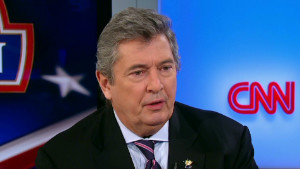 Next steps in Chris Dorner case
Next steps in Chris Dorner case  Track the events leading up to manhunt
Track the events leading up to manhunt Frequently, when a body has been burned, fingerprints are not a viable option for identification, as the skin has burned, he said. But it's rare, even in the most severe burning, that "some fragments of dental evidence" wouldn't exist.
Typically, medical examiners or other forensic experts would start with a person's family, asking relatives if they know the person's dentist, Bernstein said.
If a dentist remains unknown, other sources for dental X-rays can be checked. Those might include the military, if a person was in the armed forces, or even jail, where an inmate might have been treated for a dental condition.
Dorner, for instance, retired from the Navy Reserve on February 1 as a lieutenant.
Although Bernstein is not involved in the Dorner case, "I think that all the elements are there for a possible identification," he said. "Dental identifications are so much quicker and so much less expensive than DNA."
If dental records cannot be found, authorities can also check with hospitals for any other X-rays that might have been taken, said Dr. Daniel Spitz, medical examiner in Macomb County, Michigan. Chest or orthopedic X-rays can be particularly useful for comparisons, he said.
If no X-rays can be found, experts said the next step would be DNA testing. In spite of the fire damage, there are a number of ways DNA can be located on a body, Bernstein and Spitz said.
"The charring is only on the surface," unless an accelerant was used or unless the body was subjected to "crematory-like temperatures," causing it to disintegrate, Spitz said.
DNA can be extracted from the center of a tooth or from bone marrow, Bernstein said.
In addition, "the skull almost always stays, for the most part, intact, leaving the brain in relatively good shape," Spitz said. Internal organs sometimes are also present, and blood can be drawn from them.
Timeline in manhunt for ex-L.A. cop turned fugitive
If a person's DNA is not found in national DNA databases, a source for comparison must be found, he said. Authorities may obtain a sample from a person's toothbrush or hairbrush, for instance, and tests may also be done comparing blood samples from family members, although those are more labor-intensive and time-consuming.
But in most cases, dental records are all that's needed, Bernstein said. "It's typical that we can do that."
In this case, he said, "They're going to do everything they can to identify this individual. It's critical."
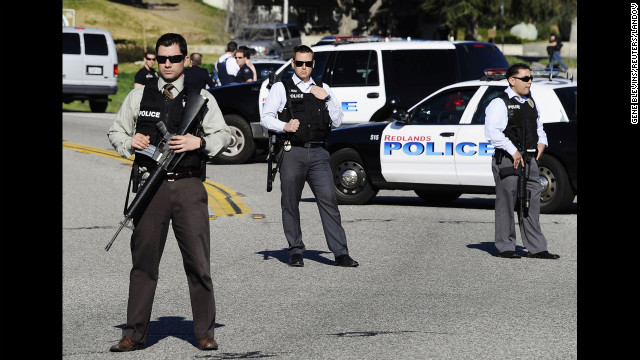 Authorities take positions during the manhunt for former LAPD officer Christopher Jordan Dorner near the town of Angelus Oaks, California, on Tuesday.
Authorities take positions during the manhunt for former LAPD officer Christopher Jordan Dorner near the town of Angelus Oaks, California, on Tuesday. 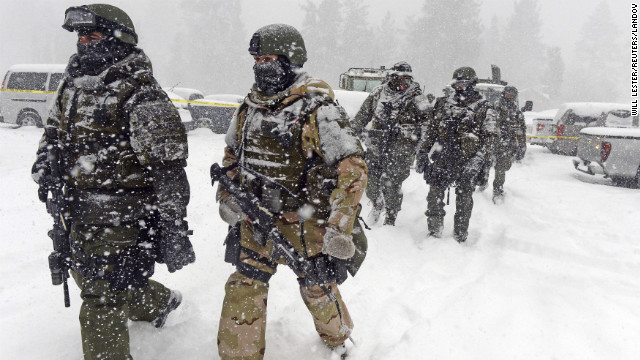 San Bernardino County Sheriff SWAT team members return to the command post at Bear Mountain in Big Bear Lake, California, on Friday, February 8, after heavy snow hindered the manhunt for ex-LAPD cop Christopher Jordan Dorner.
San Bernardino County Sheriff SWAT team members return to the command post at Bear Mountain in Big Bear Lake, California, on Friday, February 8, after heavy snow hindered the manhunt for ex-LAPD cop Christopher Jordan Dorner. 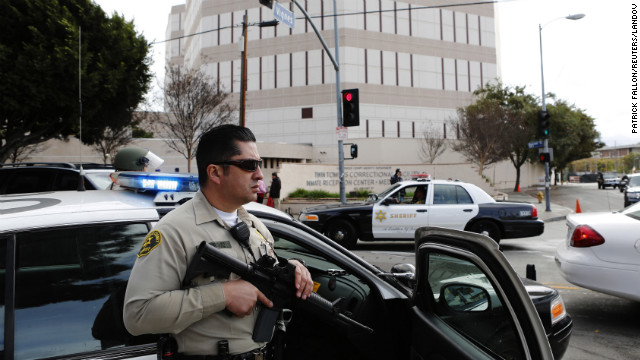 Officers keep watch outside of the Twin Towers Jail in response to an unconfirmed sighting of Dorner in Los Angeles.
Officers keep watch outside of the Twin Towers Jail in response to an unconfirmed sighting of Dorner in Los Angeles. 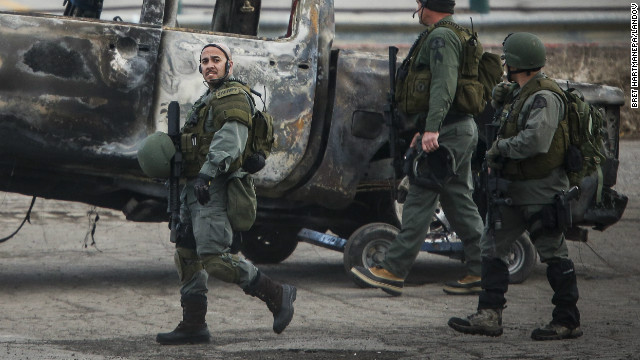 Officers investigate the burned out truck of Christopher Jordan Dorner that was discovered at the base of Bear Mountain Ski Resort in Big Bear Lake, California, on Thursday, February 7.
Officers investigate the burned out truck of Christopher Jordan Dorner that was discovered at the base of Bear Mountain Ski Resort in Big Bear Lake, California, on Thursday, February 7.  Department of Homeland Security officers search vehicles at the San Ysidro Port of Entry in San Diego on February 7 as they search for former LAPD officer Christopher Dorner.
Department of Homeland Security officers search vehicles at the San Ysidro Port of Entry in San Diego on February 7 as they search for former LAPD officer Christopher Dorner. 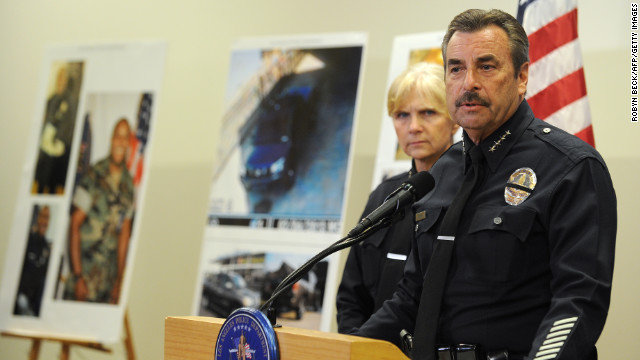 Los Angeles Police Chief Charlie Beck speaks at a press conference about the manhunt for Dorner as photos of the suspect stand in the background on February 7.
Los Angeles Police Chief Charlie Beck speaks at a press conference about the manhunt for Dorner as photos of the suspect stand in the background on February 7.  An illuminated sign at San Diego State University along Interstate 8 displays information about Dorner's last known vehicle on February 7.
An illuminated sign at San Diego State University along Interstate 8 displays information about Dorner's last known vehicle on February 7. 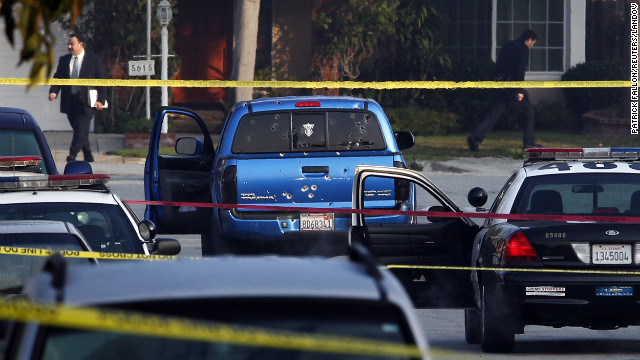 Detectives investigate the scene where officers fired on a vehicle they believed was Dorner's on February 7, in Torrance, California. Two people in the truck were wounded.
Detectives investigate the scene where officers fired on a vehicle they believed was Dorner's on February 7, in Torrance, California. Two people in the truck were wounded. 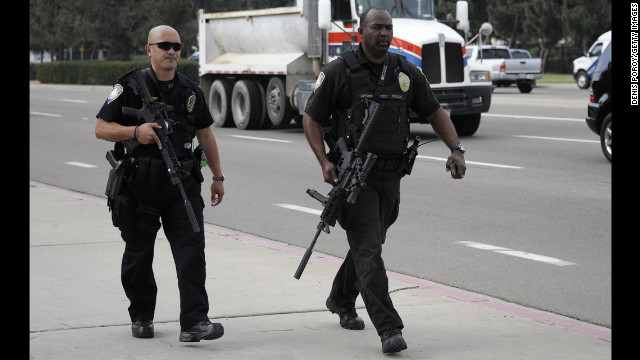 San Diego Harbor Police officers near Naval Base Point Loma armed with high-powered firearms walk along a street on February 7 in San Diego.
San Diego Harbor Police officers near Naval Base Point Loma armed with high-powered firearms walk along a street on February 7 in San Diego. 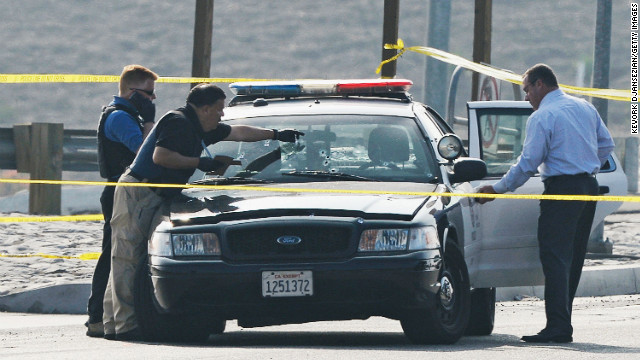 Investigators inspect a bullet-ridden squad car where a police officer was shot on Magnolia Avenue in Corona, California on February 7.
Investigators inspect a bullet-ridden squad car where a police officer was shot on Magnolia Avenue in Corona, California on February 7. 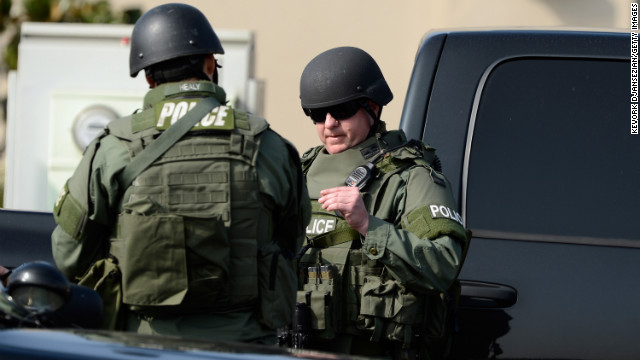 Police stand guard near a LAPD car where a police officer was shot on Magnolia Avenue as officers across the state remain on high alert. Ex-cop at center of California manhunt Ex-cop at center of California manhunt Ex-cop at center of California manhunt Ex-cop at center of California manhunt Ex-cop at center of California manhunt Ex-cop at center of California manhunt Ex-cop at center of California manhunt Ex-cop at center of California manhunt Ex-cop at center of California manhunt Ex-cop at center of California manhunt Ex-cop at center of California manhunt Ex-cop at center of California manhunt HIDE CAPTION << <
Police stand guard near a LAPD car where a police officer was shot on Magnolia Avenue as officers across the state remain on high alert. Ex-cop at center of California manhunt Ex-cop at center of California manhunt Ex-cop at center of California manhunt Ex-cop at center of California manhunt Ex-cop at center of California manhunt Ex-cop at center of California manhunt Ex-cop at center of California manhunt Ex-cop at center of California manhunt Ex-cop at center of California manhunt Ex-cop at center of California manhunt Ex-cop at center of California manhunt Ex-cop at center of California manhunt HIDE CAPTION << <
{ 0 comments... read them below or add one }
Post a Comment